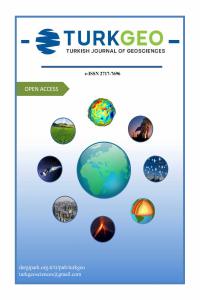
Turkish Journal of Geosciences
Yazarlar: ["Edmond PASHO", "Arben Q. ALLA", "Ernest RAMAJ"]
Konular:-
DOI:10.48053/turkgeo.1150655
Anahtar Kelimeler:Forest,Burn severity,DNBR,Landsat 8,Regeneration
Özet: Assessment of forest areas affected by wildfire is crucial for designing appropriate management strategies to support post-wildfire restoration. This study integrates Remote Sensing and GIS data to map burned areas and severity, and regeneration of vegetation in a Mediterranean forest type ecosystem (National Park "Dajti Mountain", NPDM), in Albania. Landsat 8 satellite imagery was employed to calculate various spectral indices such as the Normal Burn Ratio Index (NBR), NBR2, the Normalized Difference Vegetation Index (NDVI) and the Enhanced Vegetation Index (EVI). Burn severity levels were defined by using the dNBR thresholds developed by Key and Benson (2006). The accuracy of burn severity map produced was evaluated by relating field-based Composite Burn Index (CBI) and satellite-derived metrics (dNBR) from Landsat-8. By means of dNBR and dNBR2 we detected and mapped several burned forest areas within the NPDM, at the sites of Shkallë, Qafëmolle, Ibë, Tujan, Derje, Selbë, Surrel and Dajt, which were affected by wildfire during the year 2017. The dNBR produced the best results for burned areas mapping and burn severity assessment (91.7%) over the dNBR2 (89.8%). The dNBR and dNBR2 index maps showed that a total of 103.59 and 105.72 hectares of forests was affected by wildfire. Areas with different levels of burn severity were detected: 17.29 and 23.80% unburned, 43.36 and 45% low, 15.11 and 12.13% moderate, 24.93 and 21.2% high. Overall, the dNBR2 index produced lower percentages of wildfire-affected areas at high and moderate rates compared to the dNBR index while for unburned areas the dNBR2 index resulted in higher percentages. Vegetation recovery during the subsequent growing season was generally good as revealed by the high dNDVI and dEVI values, indicating the reactivation of photosynthetic activity. This information is useful for forest managers/specialists to design relevant strategies for the proper rehabilitation/management of burned forest areas in the future.